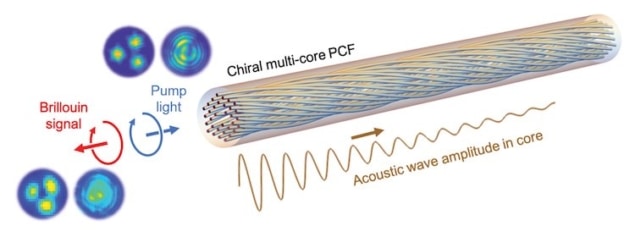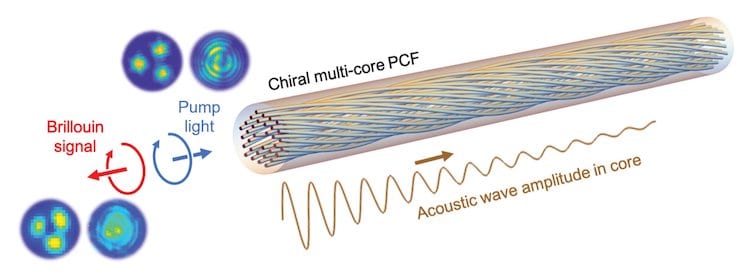
Ordinarily, light transmits the same in both directions: if I can see you, you can see me. Now, however, researchers have created a device that uses travelling sound waves to break this symmetry, thereby reducing unwanted optical phenomena such as backscattering. The new device is the first to produce this beneficial effect for selective optical vortices, which are used in optical communications, and it could also have applications for optical tweezers and vortex-based lasers.
Vortices are ubiquitous in nature – in gases, fluids, plasma and DNA, for example. In optical vortices, the wavefront of a beam of light spirals around the beam’s central propagation axis, taking on a helical shape with zero intensity at the core. This spiralling effect comes about because light carries orbital angular momentum (OAM). This form of angular momentum is distinct from the more familiar spin angular momentum, which manifests itself in polarization, and was only discovered in 1992.
Because information can be encoded in OAM, optical vortices show much promise for multiplexing, which is the process of sending multiple optical signals down a single fibre with minimal interference or other detrimental effects. As yet, however, it has been challenging to make devices in which certain vortex models propagate in one direction only. This is due to a fundamental principle of optics known as reciprocity, which implies that light signals will propagate freely in both directions through an optical fibre. Such two-way traffic can cause problems like backscattering that reduce the strength of the transmitted signal.
Sound waves manipulate optical waves
A team led by Xinglin Zeng, Philip Russel and Birgit Stiller of the Max Planck Institute for the Science of Light has now used propagating sound waves to break this light transmission reciprocity for chosen vortex models. In their work, they used the sound waves to manipulate optical waves in a chiral photonic crystal fibre via an interaction known as topology-selective stimulated Brillouin-Mandelstam scattering. The researchers explain that as the sound waves travel in one direction, they naturally enable non-reciprocal behaviour for the optoacoustic interaction. In this way, OAM modes can be either strongly suppressed or amplified, preventing random backscattering and thus minimizing signal degradation.
Stiller and colleagues report that their new device can be reconfigured as an amplifier or as an optical vortex insulator by adjusting the frequency of the control signal. Indeed, they demonstrated a vortex isolation of 22 decibels, which compares well with the best fundamental mode isolators that use stimulated Brillouin-Mandelstam scattering.

Researchers find ‘lost’ angular momentum
According to Stiller, potential applications of the device include OAM-based quantum communication and entanglement schemes as well as classical optical communications that use OAM modes (both fundamental and higher order) to increase the capacity of the communication channels. “The possibility of selective manipulation of vortex modes by light and sound waves [is] a very fascinating concept,” Stiller says.
The researchers, who detail their work in Science Advances, now plan to study more exotic sound waves that have unusual structures. “We want to see how they these waves interact with light in chiral optical fibres,” Stiller tells Physics World.
